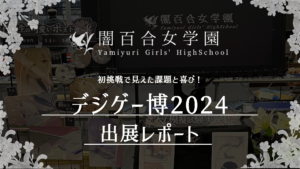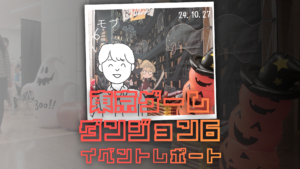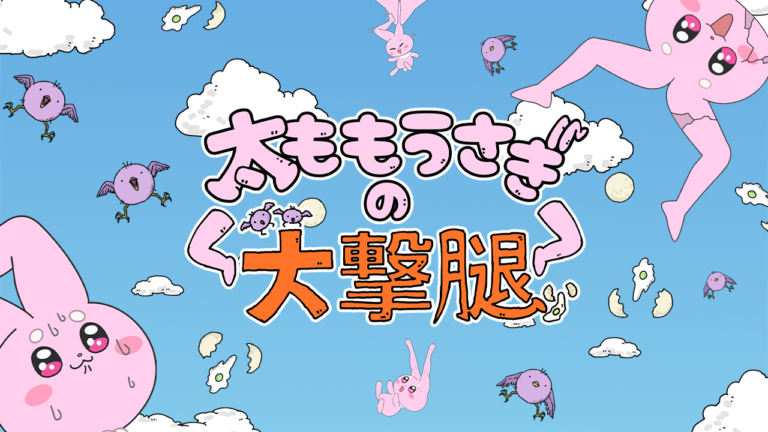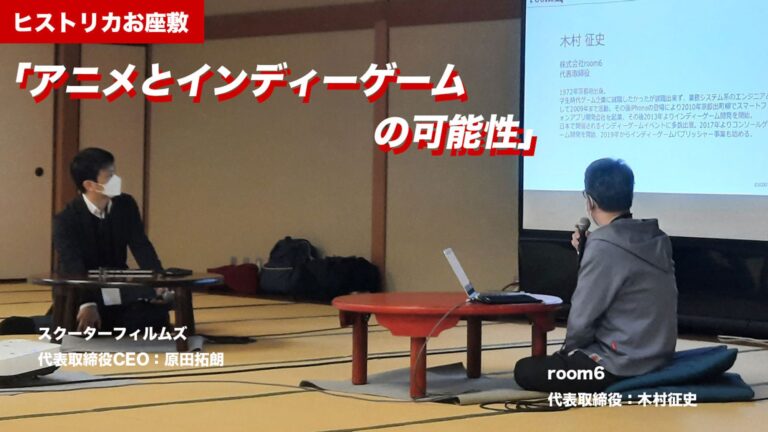-1024x576.png)
Hello, my name is Lee Hana. This time, I would like to continue discussing the Korean indie game event, Burning Beaver 2024, following the first part of the report.
In the first part of the Burning Beaver 2024 report, I introduced three works: 『Time to Live』『ハロワンダーバンド』『ソヒ』. Each of these works weaved stories in unique ways, deeply resonating with players.
Now, there are still more works that I encountered at this event. The pieces I will introduce this time astonished me in different ways. To be honest, at first, I thought, “Wait, is this really a game?” about all of them. However, once I actually played them, I was drawn in by their novelty and found myself completely engrossed.
Through encounters with works that play in entirely different ways, I was prompted to reconsider the possibilities of games. I hope to share that excitement and discovery with all of you.
An Adventure Experiencing the Daily Life of Visually Impaired People―『SOUNDSCAPE』
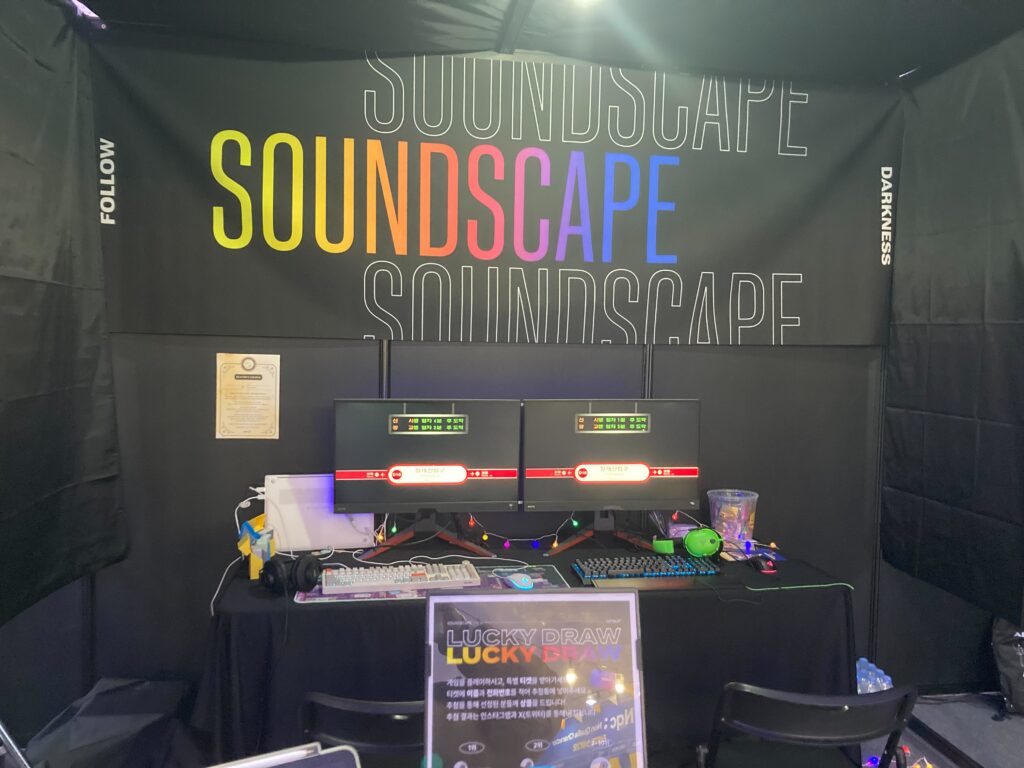
The team “OFFBEAT” at booth 88 presented 『SOUNDSCAPE』, an adventure game that explores a subway station from the perspective of visually impaired individuals. It features a unique system that allows players to navigate the space with limited means.
A New Interpretation of Existing Systems
At first glance, this work might be seen as a “copy” of the system known from the horror game 『LIDAR.exe』. However, it brilliantly reinterprets the system from the perspective of daily spatial awareness for visually impaired people, rather than inciting anxiety or fear in the dark.
Players explore the subway station step by step, as if visiting for the first time, without being chased by anyone. The choice to faithfully recreate an actual subway station in Korea reveals the developers’ intentions. It was impressive how they depicted it not merely as a horror experience but as an “adventure” in an unseen world.
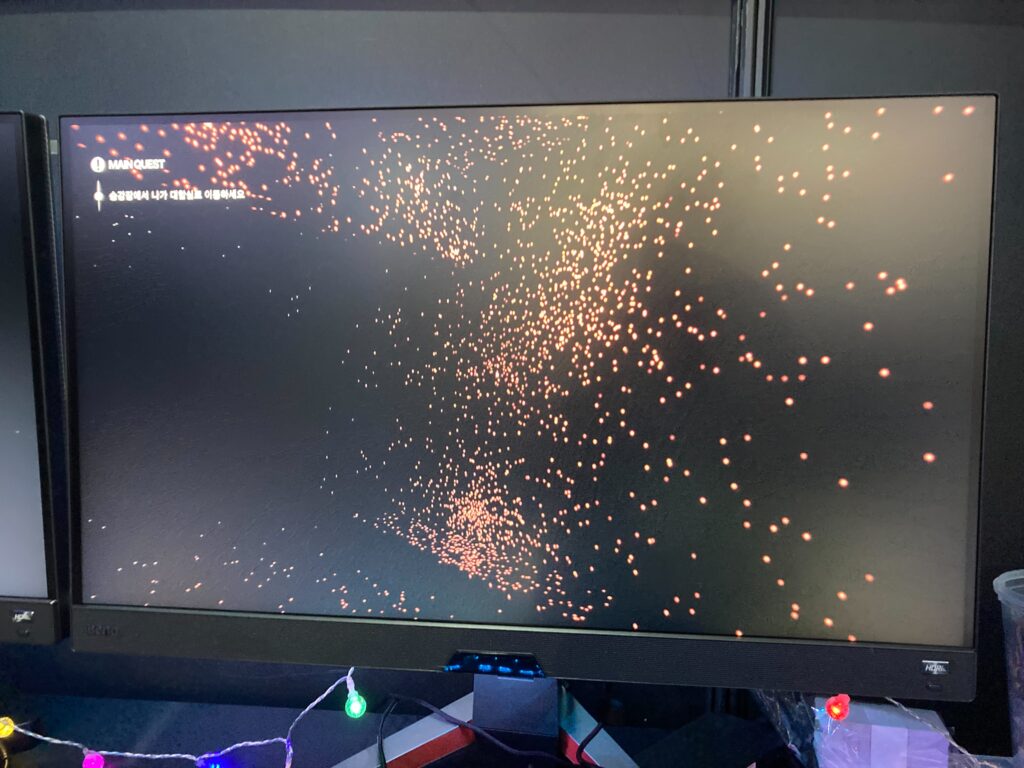
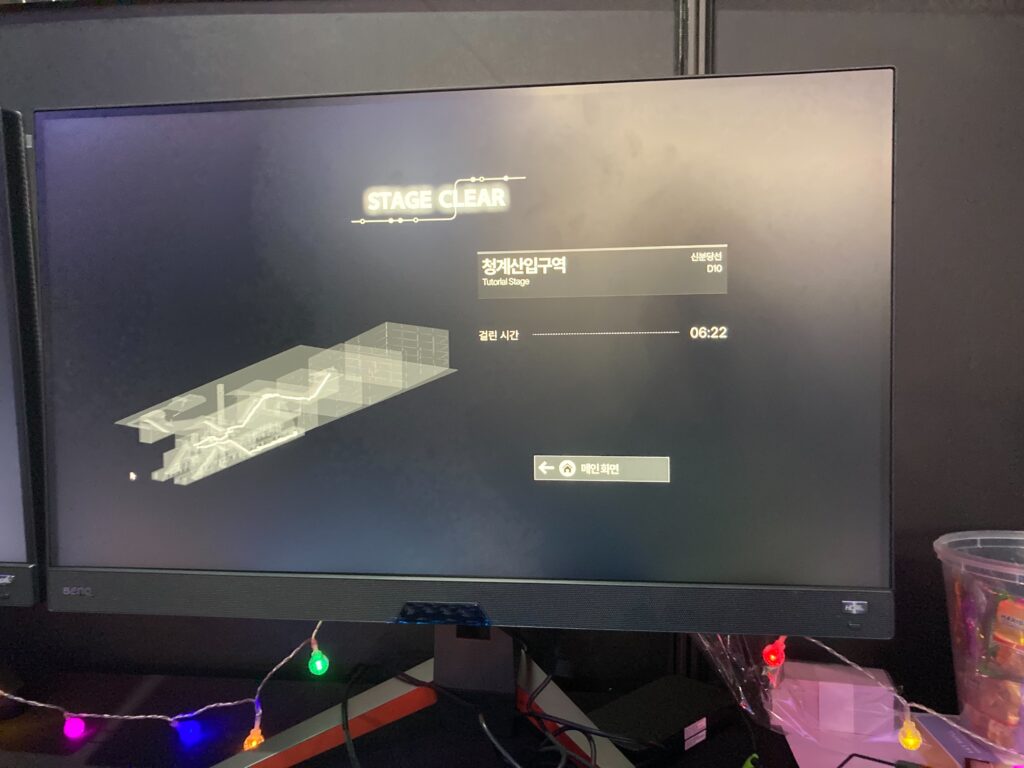
Elevating Empathy and Respect
What was interesting in my conversation with the developers was their focus on elevating the influence from 『LIDAR.exe』 into content imbued with empathy and respect for visually impaired individuals. This was evident in the design of their booth materials, where they creatively used subway ticket designs for the raffle tickets, conveying the booth’s color without touching on visual impairment.
Challenges of Localization
By faithfully recreating a Korean subway station, Korean users can directly experience how the space they use casually feels to visually impaired individuals. As they expand overseas in the future, how they will localize this “place” will be an intriguing challenge.
A Work Reflecting Deep Understanding of Subculture―『破滅のオタク』
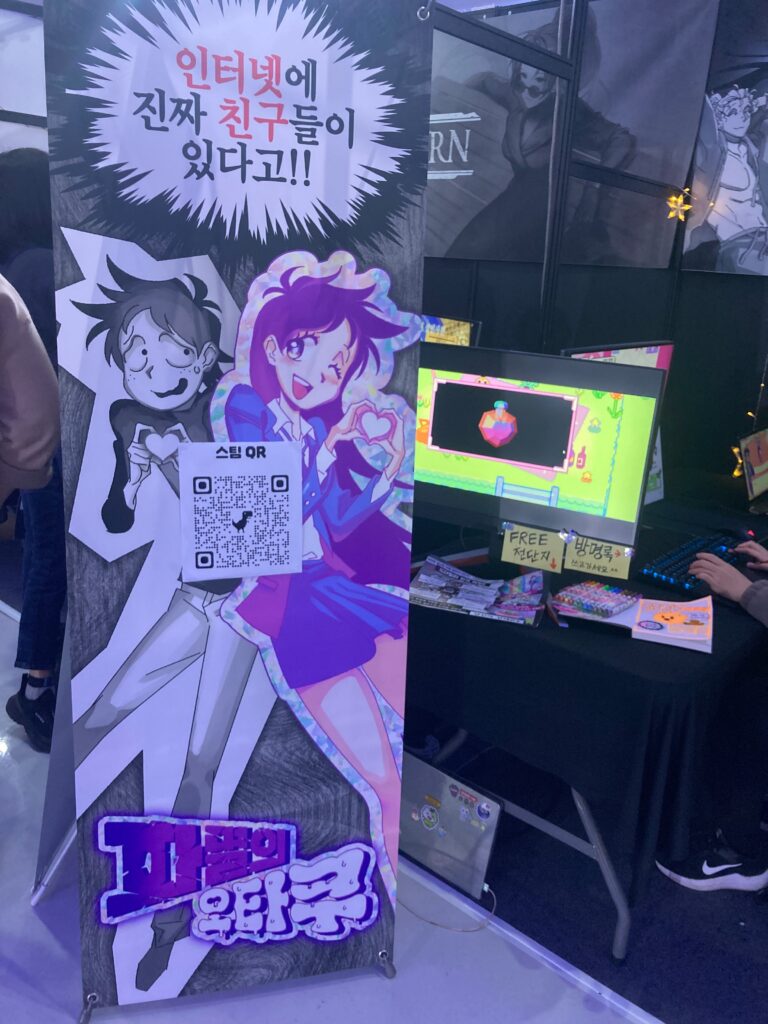
Displayed at booth 70, 『破滅のオタク』 is an adventure visual novel game developed by the team “KiwiSaurus”. A demo of the early version is currently available on STOVE, with plans for distribution on Steam.
Overwhelming Visuals and Reality
The diverse graphics that alternate between 2D illustrations and pixel art evoke the quality reminiscent of 『NEEDY GIRL OVERDOSE』. The story begins with the protagonist, a passionate otaku of Japanese online games, becoming the coordinator for a group purchase of limited-edition merchandise released in Japan, only to misuse the 5 million won entrusted to them.
The self-deprecating narration of characters and the unique conversations typical of otaku communities showcase the creators’ deep understanding and sense of subculture. This is likely why many players describe it as “creepy realism.”
At the same time, the gameplay is enriched with systems that traverse between digital and reality, graphics reminiscent of 『OMORI』 and 『UNDERTALE』, and map designs, demonstrating a remarkable balance between subcultural elements and gameplay.
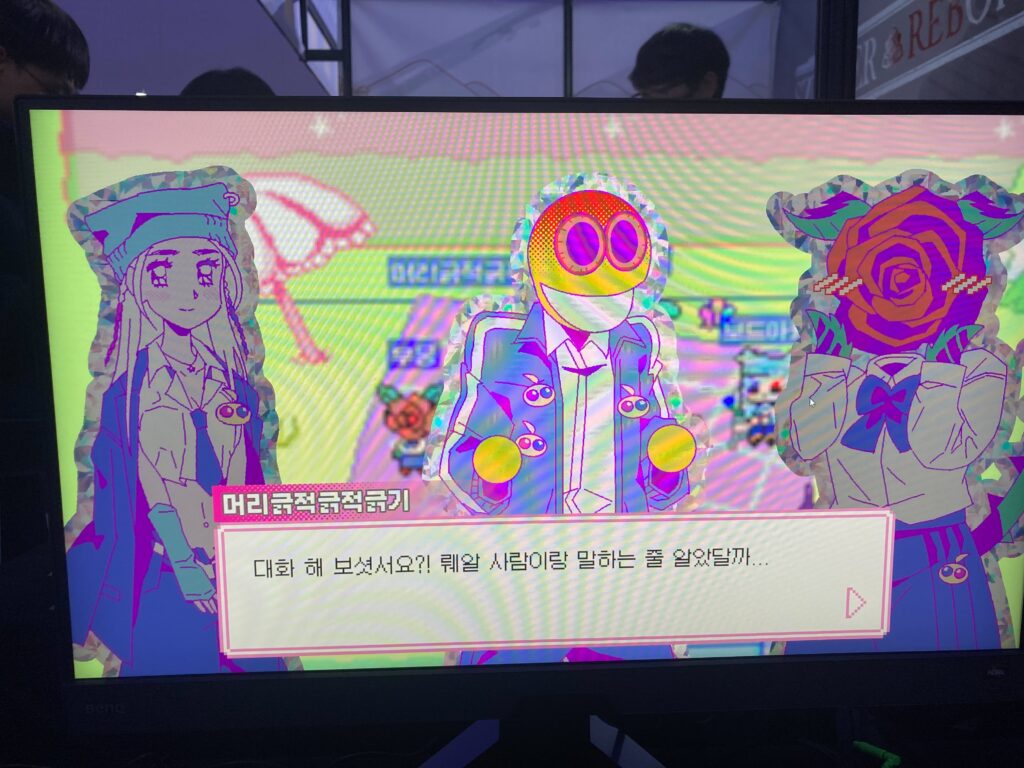
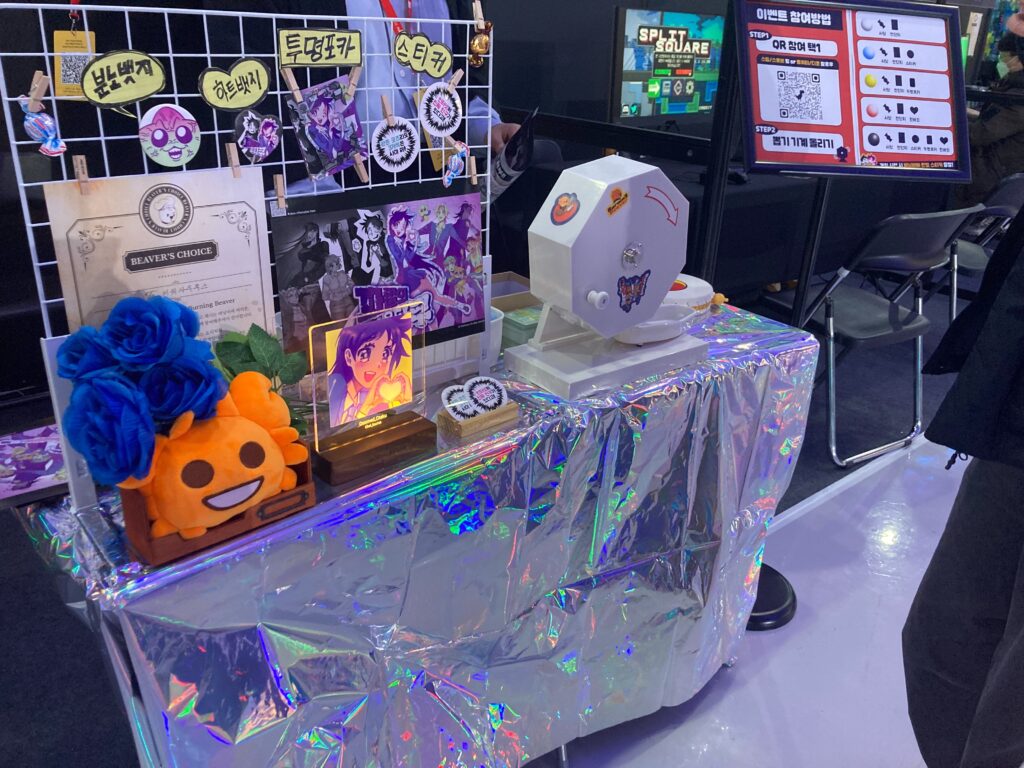
A Development Attitude Learning from Player Actions
Due to the popularity of the booth, my time to converse with the developers was limited, but a moment during gameplay left an impression. I decided to visit in the evening to see the “statue rumored to move at night” that appears in the game. Unfortunately, the event of the statue moving did not occur, but I overheard a developer muttering, “Should we add a feature for it to move at night?” This showed their commitment to finding improvement points based on user reactions.
Crossing the Barriers of Localization
This work beautifully expresses Korean subculture while cleverly weaving in the setting of Japanese idol game fans. However, its unique expressions may pose challenges even for localization into Japanese. In fact, the Steam version is currently only available in Korean.
Due to its innovative design and sense, it is a work that leaves one eagerly anticipating its expansion into more regions and countries.
A Perfect Fusion of Puzzle and Action―『The Genius Hamster』
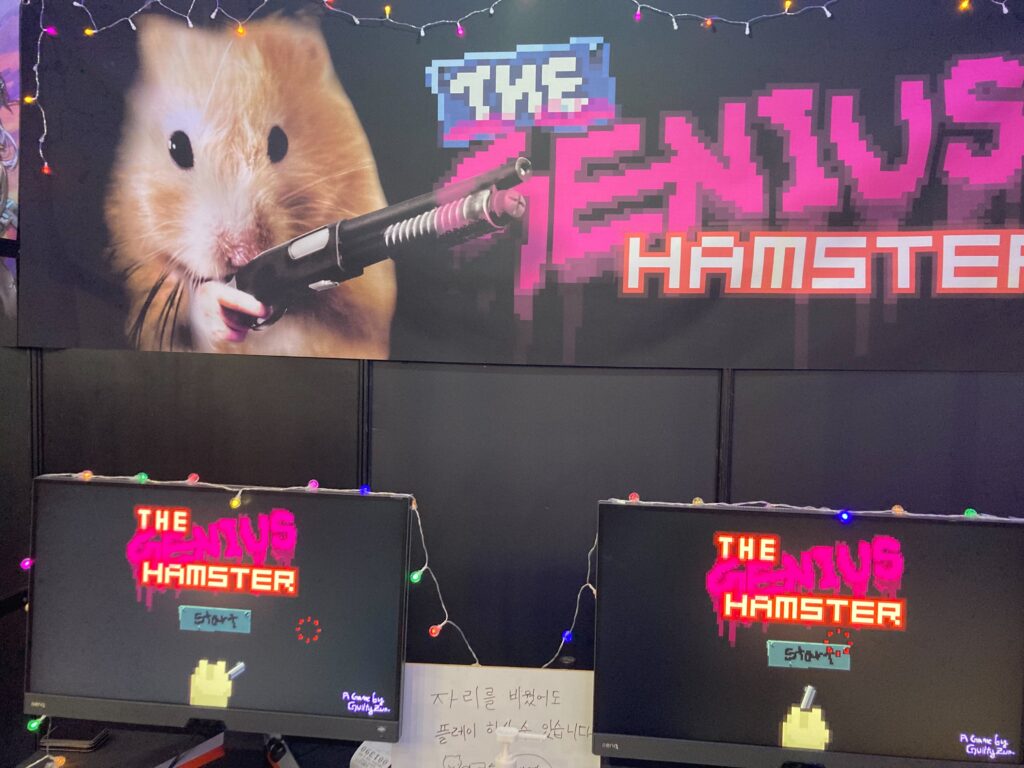
Developed by solo developer “GuiltyZun” at booth 81, 『The Genius Hamster』 is a unique action puzzle game that accurately expresses the three elements of hamsters, guns, and puzzles.
Switching Between Peace and Chaos
The basic system follows the puzzle game “SOKOBAN,” but features a unique mechanism where players can pull out a gun when they get stuck. The puzzle-solving mode is characterized by a gentle BGM and the sight of hamsters running around in a meadow, but as soon as the gun is drawn, enemies hidden among the blocks appear, and the game switches to action mode. The transition to a darkened screen and tense BGM, while dodging bullets and destroying blocks, creates an unexpectedly enjoyable experience.
Moreover, the method of retreating from action mode is also excellent. When the surrender button is pressed, the hamster waves a white flag while shedding tears, and when the gauge is full, a giant hand appears from above to return the hamster to its original position. The developer mentioned in a past interview that they wanted to depict the act of a hamster holding a gun as a cute prank.
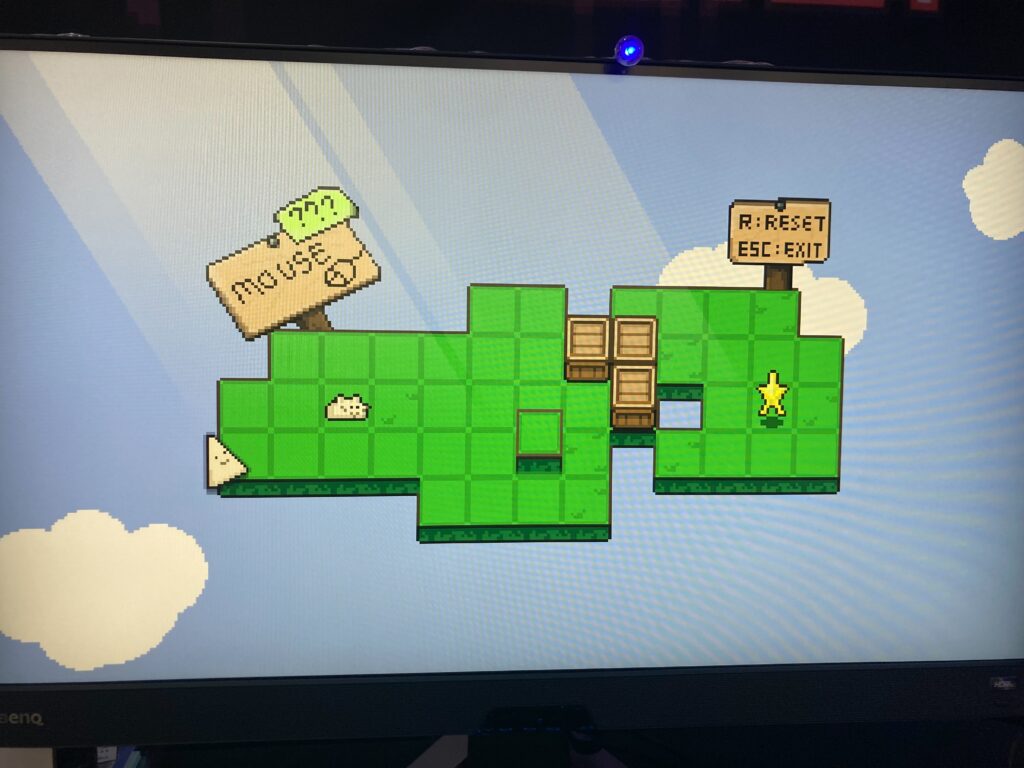
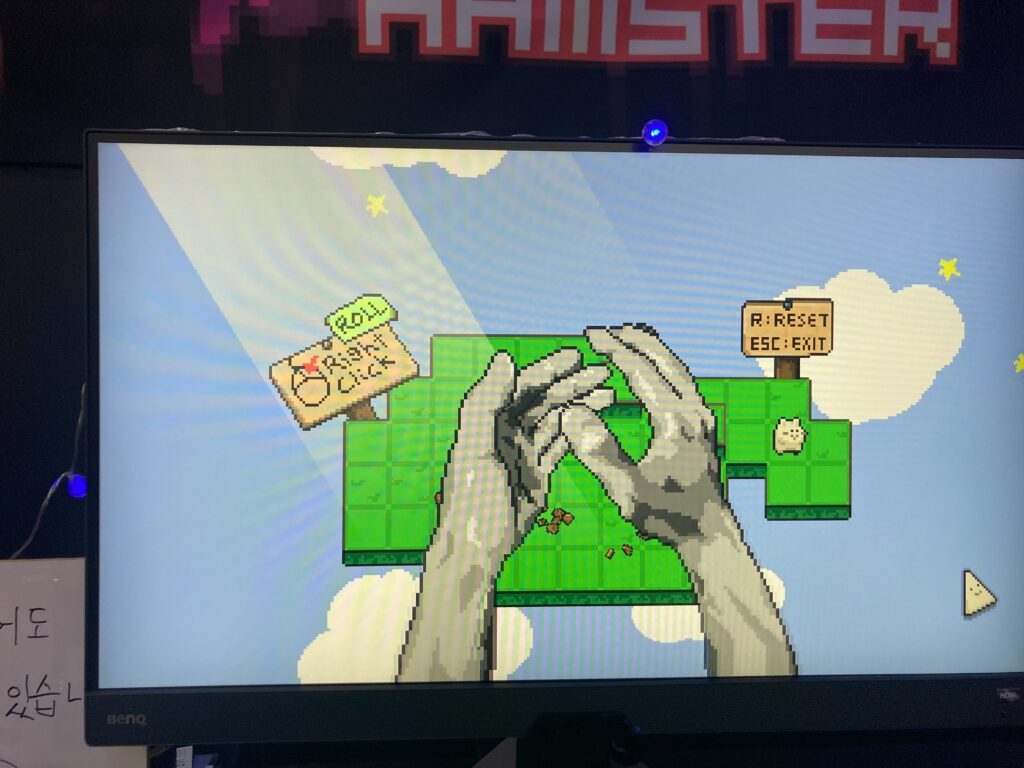
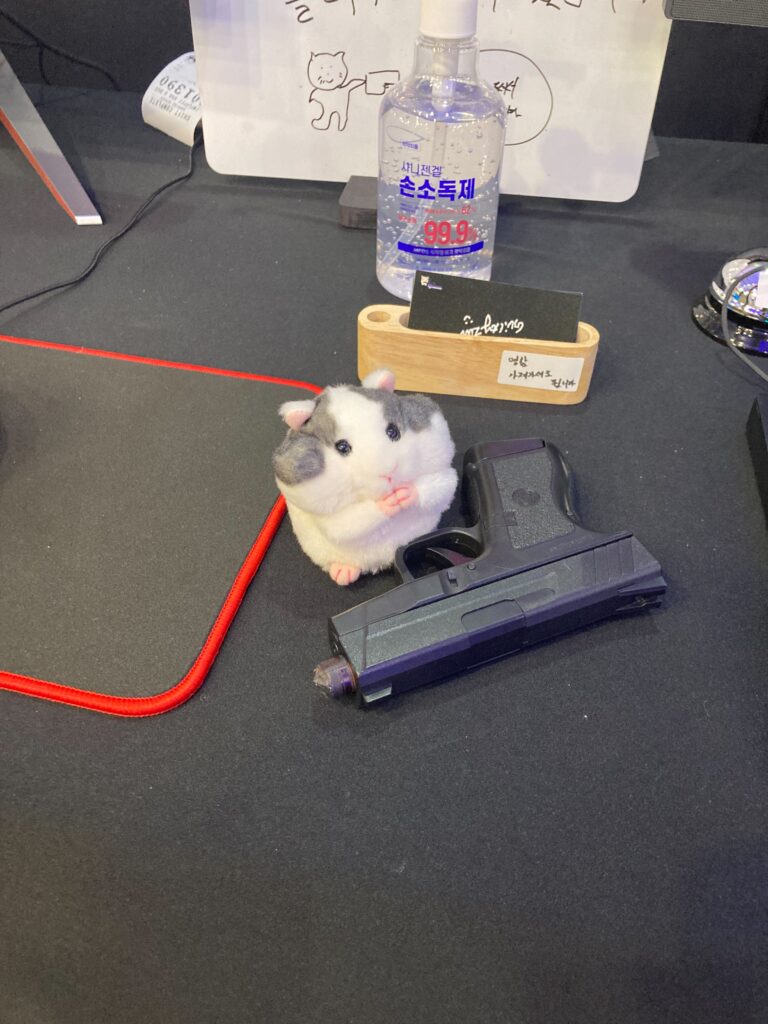
Attention to Presentation
The contrast between puzzle mode and action mode, the hamster wielding a gun larger than its body, and the giant hand from above are all sprinkled with humor in the details.
Cross-Border Appeal
This work was also a topic of discussion at BIC2024 this summer. It is packed with elements that can be enjoyed across language and cultural barriers, and it is scheduled to be exhibited at next year’s Bitsummit.
The Origin of Ideas
In the early development prototype, it was not in the current pixel art style but composed of simple shapes. However, even in that simple state, the fun of the game was sufficiently conveyed. The ability of the developers to conceive such a project while having a clear image of the final form was impressive.
Exploring New Possibilities of “Games”―『IMAGE ARCHAEOLOGY』 and 『BARC』
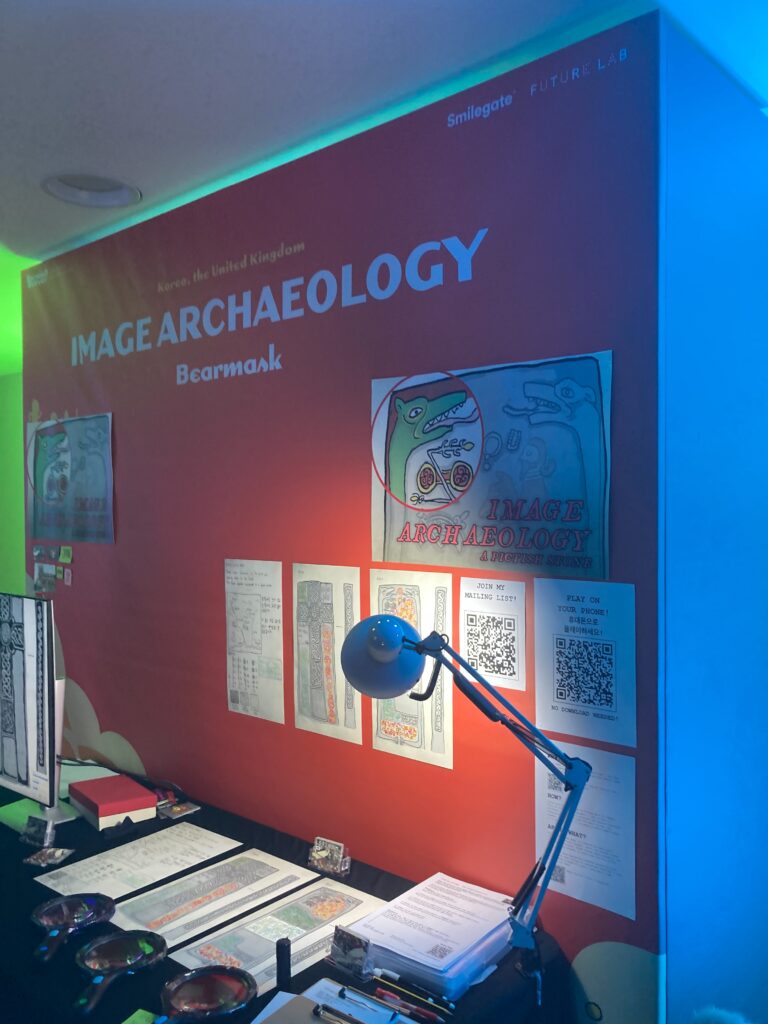
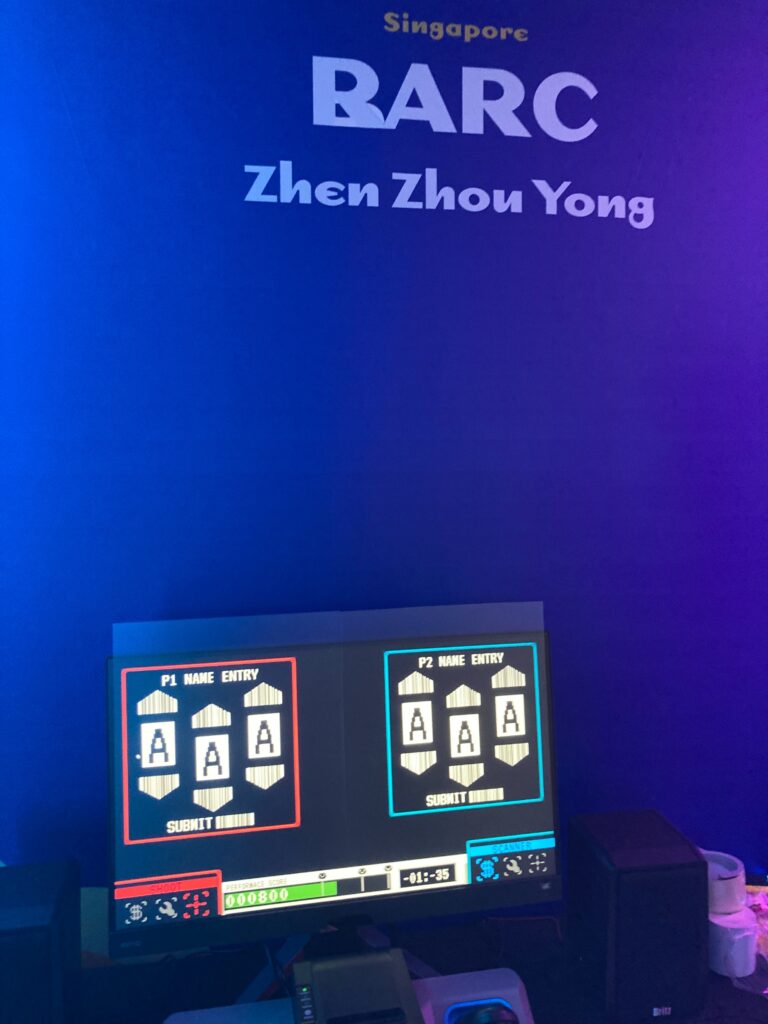
Finally, I would like to introduce two works I encountered in the exhibition area of the venue. These are interactive video games that transcend traditional gaming boundaries, created by overseas developers Bearmask and Zhen Zhou Yong.
Unraveling the Mysteries of Ruins―『IMAGE ARCHAEOLOGY』
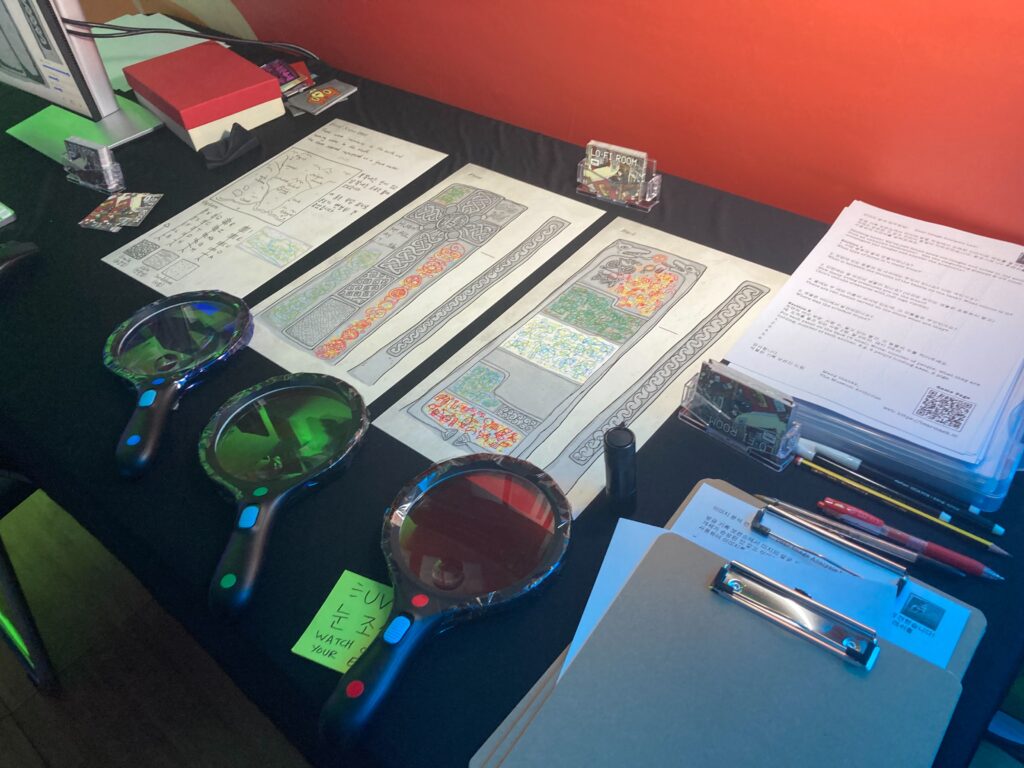
With ancient ruins drawn on two large sheets of paper, mysterious instructions, and three colored magnifying glasses, this work can be described as an archaeological experience where players use these tools to answer given questions. I relied on the developers’ explanations to progress through the puzzles, but I was more moved by the discovery of “this is a way to play” than by the number of correct answers.
Exploring the unseen with the given means, clues, and subjectivity feels like a child’s imaginative play, raising fundamental questions about “what is a game.”
The Moment Checkout Turns into Combat―『BARC』
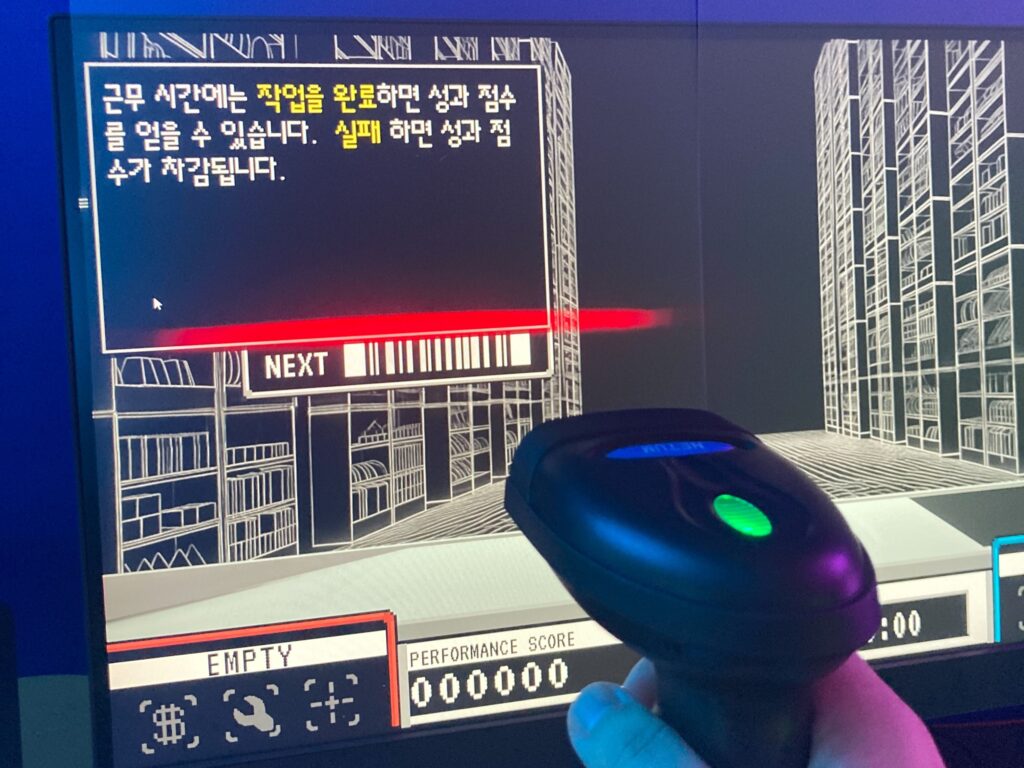
A shooting game where players fight using a receipt printer and barcode scanner as weapons. When players scan the enemy’s barcode displayed on the screen, a receipt is printed, and they must find and scan the product’s barcode listed there, creating a unique system.
At first, it feels manageable, but soon players are overwhelmed by a flood of orders pouring out of the receipt printer. For someone like me, who has actual experience working in a supermarket, the transformation of daily tasks into play was a powerful stimulus.
The Passion of the Developers
Bearmask is a developer who has lived in Korea for nine years, continuing band activities and game development alongside their main job. This work, born from an interest in historical materials, reflects the creator’s preferences. The hand-drawn diagrams of the ruins convey their enthusiasm to share the fun of the game they conceived.
Zhen Zhou Yong from BARC, despite only speaking English, gathered many players with a clear game system and appropriate localization. Even during my visit near the end of the event, I was impressed by their kindness in allowing me to play after hearing I had traveled from afar.
Play Born from Individuality
Both works convey a fresh perspective that is not typical of developers from Korea or Japan. However, this stems not from specific cultural backgrounds but rather from the developers’ individual preferences and what they find “interesting,” resulting in unique forms of play. Through this exhibition, I felt that the essence of “games” and “play” might arise from such individual passions.
Conclusion―Reflecting on Burning Beaver
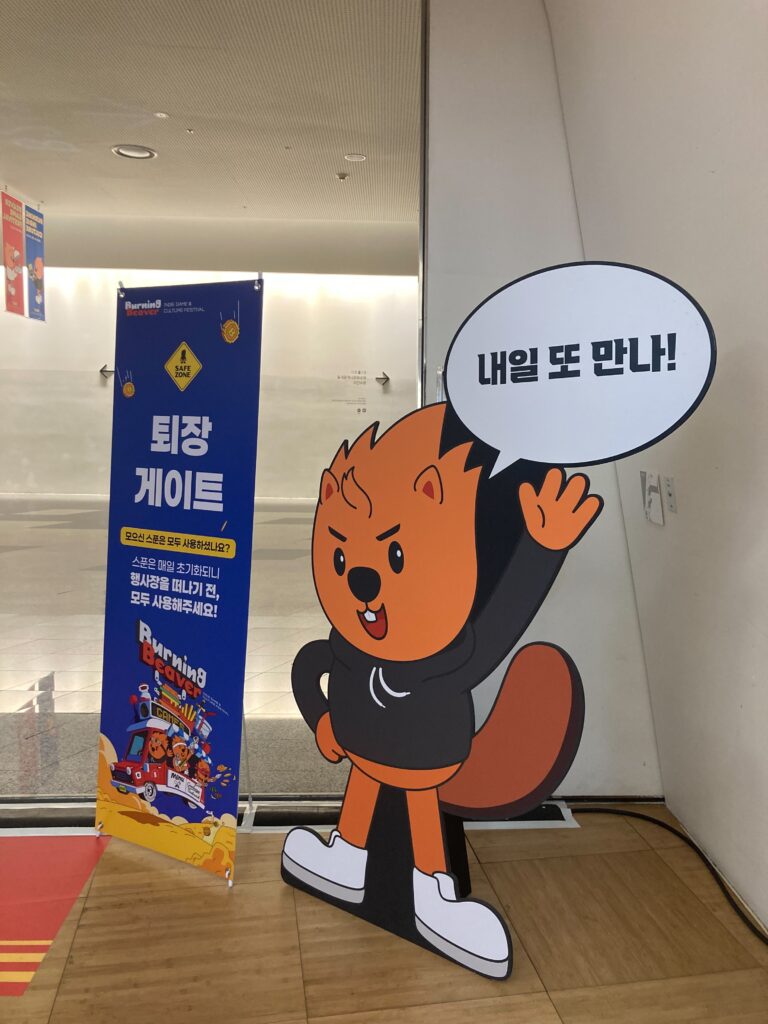
This year’s Burning Beaver 2024 was a significant event symbolizing the evolving Korean indie game scene. Despite being hosted by a major platform like STOVE, many works were seen that sincerely addressed social issues while exploring unique forms of expression, reflecting the characteristics of the Korean indie game market.
The charm of indie games always lies in experimental attempts that transcend existing frameworks and the personal preferences of the creators. In this regard, there are many commonalities between the indie scenes in Korea and Japan, but the approach of expressing delicate themes such as youth suicide, the daily lives of visually impaired individuals, loneliness, and alienation through the medium of games is a distinctive feature of the Korean indie game scene.
Particularly noteworthy is the relationship between platforms and developers. While being a platform operated by a large company, creating an environment that maximally respects the creativity of individual developers may provide rich insights for the future of the indie game market in Japan.
Many of the works I encountered are looking towards future expansions in various countries, including Japan. I sincerely hope that more indie games will interact and stimulate each other across national and cultural boundaries. I also look forward to the new Korean indie game event “Burning Beaver” becoming a bridge for such exchanges.

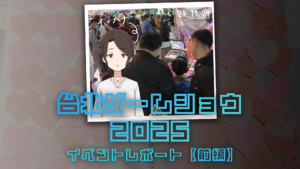
![“New Indie Game Festival from South Korea – Burning Beaver 2024 Report [Part 1]”](https://skoota.jp/media/wp-content/uploads/2024/12/SKOOTA_BBレポハナサムネ-1-300x169.png)

